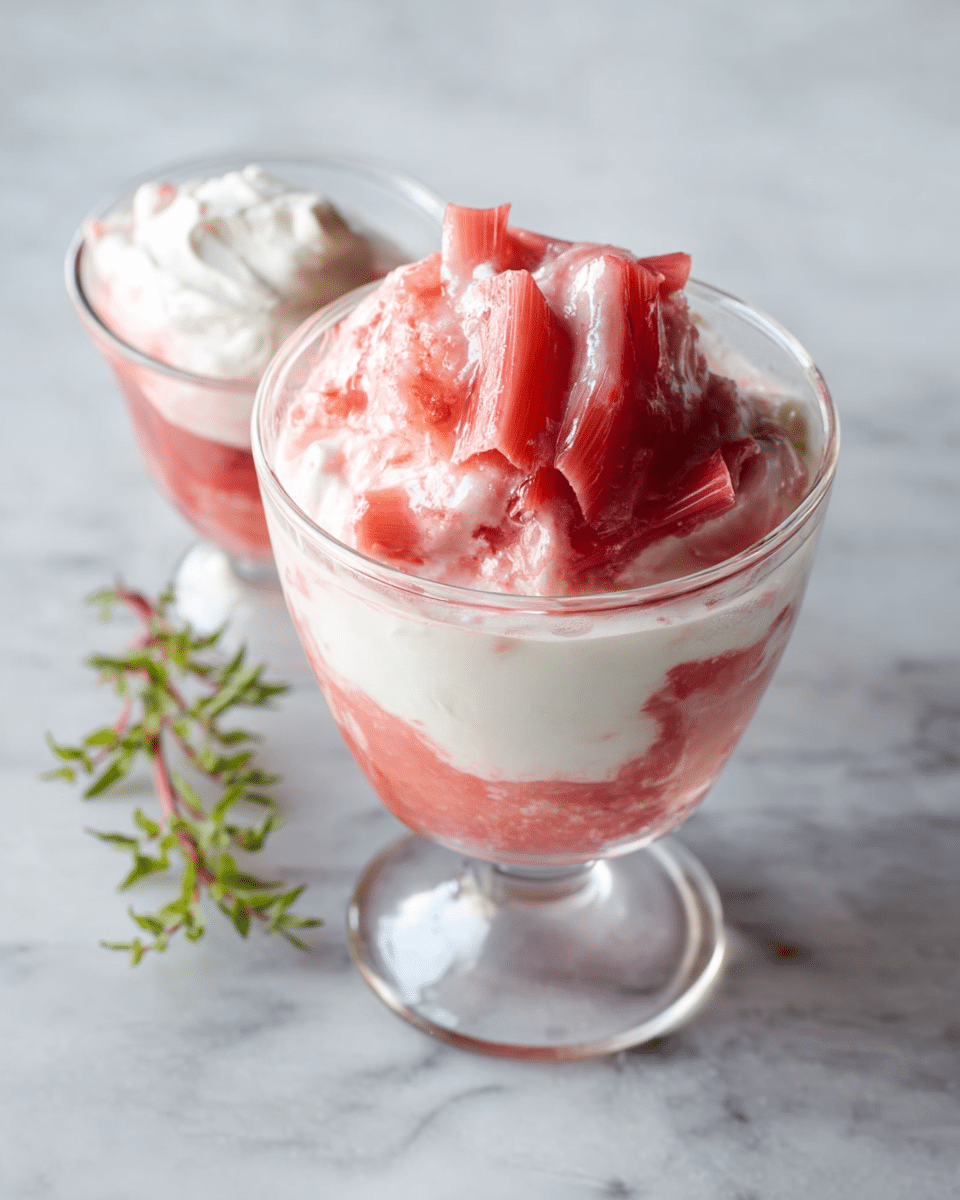Light, creamy, and laced with the tart brightness of spring rhubarb, this traditional British dessert is a celebration of simplicity and seasonal flavor. Rhubarb Fool folds sweet-tangy compote into pillowy whipped cream for a cloud-like texture that melts in your mouth.
This dessert is perfect for dinner parties, garden picnics, or whenever you want to indulge in something fresh and beautiful with minimal effort. The contrast of silky cream and rhubarb’s zingy bite makes each spoonful an irresistible experience. Serve it chilled for a dreamy end to any meal.
Full Recipe:
Ingredients:
-
1 pound fresh rhubarb, rinsed, ends trimmed, cut into ½-inch slices
-
¼ cup granulated sugar
-
2 cups heavy whipping cream
Directions:
-
In a medium saucepan over medium-high heat, combine rhubarb and sugar. Cover and let it come to a simmer, cooking for 5 minutes, stirring occasionally.
-
Reduce heat to low, stir again, cover, and cook another 3 minutes until the rhubarb is tender and begins to break down. Stir more for a smoother compote; stir less for chunkier texture.
-
Pour the rhubarb mixture into a fine-mesh sieve set over a bowl to separate juice from pulp. Let both cool completely.
-
In a mixing bowl, whip the heavy cream to soft peaks. Gently fold in the rhubarb pulp until combined, creating a light salmon-hued swirl.
-
Spoon into serving glasses or bowls, drizzle with reserved rhubarb juice, and chill for at least 1 hour before serving.
Prep Time: 10 minutes | Cooking Time: 10 minutes | Total Time: 1 hour 20 minutes (includes chilling)
Kcal: 321 kcal | Servings: 6
A Taste of Tradition: The Rhubarb Fool, A Classic British Dessert
Among the many charming relics of British culinary history, the Rhubarb Fool stands out as an enduring symbol of simple, elegant indulgence. It’s a dish that carries with it the nostalgia of grandmothers’ kitchens, the brightness of spring, and the unpretentious delight of cream and fruit combined in perfect harmony. While modern desserts often emphasize complexity, precision, and visual flair, the rhubarb fool remains wonderfully straightforward a soft, swirled cloud of whipped cream and tangy stewed rhubarb, served chilled in a glass or bowl. It’s proof that sometimes the simplest things are the most memorable.
A Bit of History
The word fool in the culinary context dates back to the 16th century, and its exact origins remain a subject of debate among food historians. Some believe it could derive from the French word “fouler,” which means “to crush” or “to press,” potentially referencing the crushed fruit used in traditional versions. Early variations of fools were made with a variety of fruits, including gooseberries, apples, and plums essentially what was in season and readily available.
Rhubarb didn’t become a frequent star in British desserts until the 19th century, even though it had been introduced earlier as a medicinal plant. Once it made its debut in the kitchen, however, rhubarb was embraced wholeheartedly, especially in working-class households. It was cheap, grew easily, and when combined with sugar, its naturally tart flavor turned into a dynamic ingredient that lent itself beautifully to jams, pies, and yes, the humble fool.
The Appeal of Rhubarb
Rhubarb is one of those ingredients that splits a crowd you either love it or you haven’t yet had it prepared properly. Botanically speaking, it’s a vegetable, although most people think of it as a fruit due to its regular role in desserts. Its color is also part of its charm; when cooked, the pinkish-red stalks bleed into the cream, creating a lovely blush or salmon hue in the final presentation.
The flavor of rhubarb is assertively tart, which makes it ideal for pairing with sweet, mellow ingredients like cream or custard. It doesn’t shy away in a dish it holds its own, adds brightness, and creates a balancing act of flavors that is both refreshing and indulgent. In the context of a rhubarb fool, the tangy compote folds through the whipped cream like pink ribbons, providing a layered experience in every spoonful.
A Seasonal Celebration
Rhubarb has a relatively short season, particularly in the United States and the UK, where it typically appears in early spring and fades by early summer. This narrow window of availability is one reason why rhubarb desserts like fools, crumbles, and pies feel special they capture a moment in the year that feels fleeting and worth celebrating.
Seasonality is at the heart of many great dishes, and rhubarb fool is no exception. It speaks to the old-fashioned rhythm of eating with the seasons, enjoying what nature offers when it’s at its peak. When rhubarb begins appearing at farmers’ markets and grocery stores, it signals the end of winter’s monotony and the beginning of brighter, warmer days.
Texture and Simplicity
One of the most appealing things about rhubarb fool is its texture. There’s a softness and a silkiness to it that makes it feel indulgent, even though it contains only a few ingredients. The whipped cream offers an airy base, and the stewed rhubarb contributes a slightly thicker, fruitier texture that contrasts and complements at the same time.
Unlike custards or baked puddings, this is a no-bake dessert that requires minimal equipment and effort. There’s no crust to roll, no tempering of eggs, no baking temperatures to monitor. It’s a dish that rewards you with elegance for very little labor. Once chilled, it becomes even better cool, creamy, and utterly satisfying, especially on a warm afternoon.
A Versatile Canvas
While the traditional rhubarb fool uses just rhubarb, sugar, and cream, the beauty of the recipe is that it invites personalization. Some cooks like to add a bit of orange zest or vanilla to the cream for a fragrant twist. Others mix in mascarpone or Greek yogurt for added richness and tang.
You might also layer it like a parfait with shortbread crumbles or crushed meringue for texture, turning it into a kind of deconstructed trifle. Strawberries or raspberries can be added to the rhubarb compote for a fruitier base. A dash of elderflower cordial, a splash of rosewater, or even a swirl of honey can elevate the flavor in creative ways. The core concept remains the same fruit and cream but the execution can be as classic or as adventurous as you like.
A Dish for All Occasions
Despite its relatively simple nature, rhubarb fool is adaptable enough for a range of occasions. For a casual weeknight dinner, it’s a fuss-free dessert that can be prepped ahead and served in mismatched bowls. For a more refined dinner party, it can be piped into delicate glasses and garnished with edible flowers, candied citrus peel, or a mint sprig.
It’s also a great make ahead option. You can prepare the rhubarb compote in advance and refrigerate it for a day or two, then whip the cream and assemble when ready. This makes it an ideal dessert for entertaining, as you don’t need to be in the kitchen until the very last moment.
Why It Belongs on Your Blog (and Your Table)
In a world where recipes can sometimes feel intimidating or overloaded with trends, rhubarb fool is a breath of fresh air. Its minimalist ingredient list, lack of special equipment, and forgiving technique make it perfect for home cooks of all skill levels. More importantly, it has that rare quality of being both rustic and refined something that’s difficult to achieve without complexity.
For bloggers and food content creators, the rhubarb fool also offers strong visual appeal. The soft pastel swirls, the creamy texture, and the versatility of presentation make it a highly photographable dish. Its seasonal tie-in gives it a natural place in spring and summer content calendars, and its backstory offers plenty of space for storytelling and personalization.
Plus, it taps into current culinary values: celebrating fresh produce, reducing food waste (by using what’s in season), and returning to traditional, less-processed foods.
Conclusion:
Rhubarb fool is more than just a charming old-school dessert. It’s a testament to the beauty of seasonal ingredients, the power of simplicity, and the way food can connect us to tradition without sacrificing creativity. Whether you’re discovering it for the first time or revisiting a family classic, it offers something incredibly satisfying both in the making and in the eating.
As you plan your spring and summer content or look for that perfect dish to add to your repertoire, give this creamy, tangy British treasure a chance. It’s quick to make, endlessly adaptable, and guaranteed to delight. And in the world of modern desserts, that makes it a true standout.






